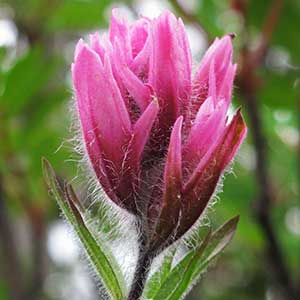Castilleja parviflora var. olympica
Olympic Indian paintbrush, Olympic Mountains paintbrush, Olympic paintbrush
broadly lanceolate, rarely linear, margins plane, (0–)3(–5)-lobed, apex narrowly acute to acuminate;
lobes spreading, linear to lanceolate, lateral lobes nearly as long as terminal.
distally pink-purple, magenta, deep rose, or crimson, rarely white, 3–7-lobed;
lobes lanceolate, arising near to above mid length.
12–20(–25) mm;
tube 8.5–19 mm;
beak exserted, (5.5–)7–9(–11) mm;
abaxial lip green;
teeth green.
deep purple with magenta or light pink lobes, 13–20(–28) mm;
abaxial clefts 6.5–12 mm, adaxial 7–15 mm, lateral 2–8 mm, 10–35% of calyx length;
lobes narrowly triangular, apex acute to obtuse.
Castilleja parviflora var. olympica
Variety olympica is essentially endemic to the upper elevations of the Olympic Mountains, in northwestern Washington, though a handful of collections from high elevations on Vancouver Island, British Columbia, are also referable to this form.
(Discussion copyrighted by Flora of North America; reprinted with permission.)


